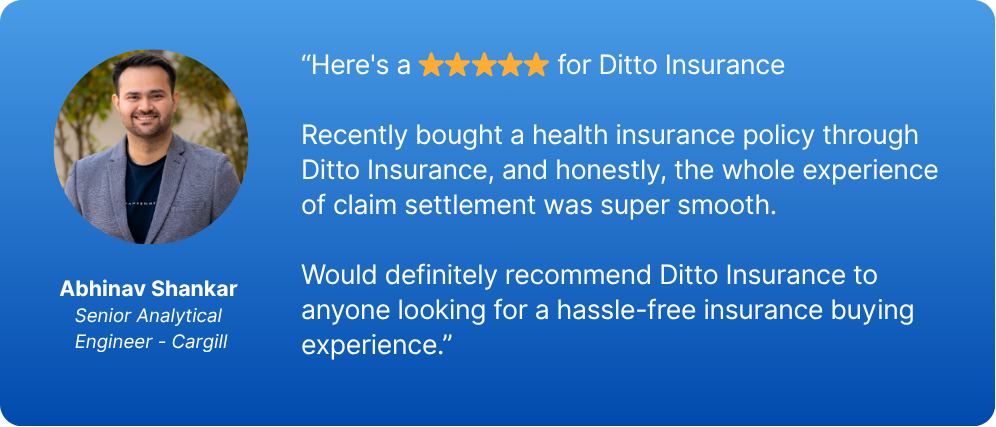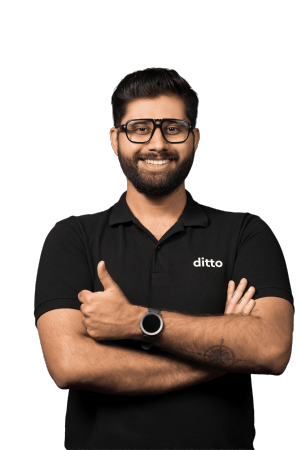Star Health Insurance vs HDFC ERGO Health Insurance: Which is Better?
In 2025, HDFC ERGO Health Insurance is the better choice overall. It consistently outperforms Star Health Insurance in key operational metrics, with a higher claim settlement ratio, fewer complaints, and a stronger track record of customer satisfaction.
While Star Health offers lower premiums and wider coverage options, HDFC ERGO’s superior reliability, smoother digital claim process, and proven consistency make it the more dependable insurer for long-term peace of mind.
Introduction
Choosing the right health insurer isn’t easy, especially when two of the biggest names, Star Health Insurance and HDFC ERGO, are often recommended side by side. Both have strong offerings, but the real question is: which one works better for you?
At Ditto, we talk to thousands of individuals every month and help them make the right insurance decisions with the guidance of our 500+ IRDAI-certified advisors. This first-hand experience, along with real customer insights, has helped us put together this detailed comparison. We've analyzed insurer public disclosure data, reviewed policy documents in detail, and assessed what each insurer brings to the table.
In this comparison guide, we explore Star Health Insurance vs HDFC ERGO Health Insurance in detail. We will also delve into their backgrounds, performance metrics, plan highlights, and premium structures of their plans.
By the end of this guide, you’ll have the insights you need to choose the insurer that best matches your health needs and peace of mind.
Star Health Insurance vs HDFC ERGO Health Insurance: Overview
Star Health Insurance
Who They Are
Diverse Offerings
Claims Handling
Performance & Reliability
Some of Star Health’s Popular Plans: Super Star, Assure and Star Comprehensive.
HDFC ERGO Health Insurance
Who They Are
Diverse Offerings
Claims Handling
Performance & Reliability
Some of HDFC ERGO’s Popular Plans: Optima Secure, Optima Super Secure, and Optima Secure Global Plus.
Confused about which insurer suits your needs? Our IRDAI-certified experts can help you make the right decision for free! So book a call now!
Star Health vs HDFC ERGO Health Insurance: Operational Metrics Comparison
Key Insights: HDFC ERGO demonstrates significantly better operational metrics than Star Health across the board.
- Claim Settlement Ratio (CSR): HDFC ERGO's 98% CSR is substantially higher than Star Health's 85%. This indicates greater reliability and efficiency in settling claims by HDFC Ergo.
- Complaint Volume: HDFC ERGO has a much lower volume of average complaints per 10,000 claims, which suggests superior customer satisfaction and smoother service.
- Incurred Claim Ratio (ICR): HDFC ERGO's higher ICR compared to Star Health's suggests a greater proportion of premiums are paid out as claims. This again implies stronger claims responsiveness.
- Network Hospitals: Both insurers have a large network, with Star Health having a slight edge.
- Annual business: Though Star health has a larger volume in the health insurance segment, overall HDFC ERGO being a general insurer is the bigger entity.
Overall, while Star Health has a larger market presence and business volume in retail health, HDFC ERGO excels in operational reliability, claim settlement, and customer satisfaction. For customers who prioritize stability and a hassle-free claims experience, HDFC ERGO is the stronger choice based on these metrics.
Star Health Insurance vs HDFC ERGO: Key Features Comparison
Below, we take a closer look at the flagship plans from both insurers: HDFC ERGO Optima Secure and Star Health Super Star Plan, to see how they compare side by side.
Note: Features like no disease-wise sub-limits, no room rent restrictions, no copayment are common across both plans. Coverage for Day Care & Modern Treatments, Domiciliary, and AYUSH are up to the Sum Insured in both plans. Both plans offer Air Ambulance cover up to ₹5L.
Star Health Insurance vs HDFC ERGO: Premium Comparison
To give you a clear view of how costs vary, we've put together a premium comparison of the most recommended plans: HDFC ERGO Optima Secure and Star Health Super Star Plan, across various age groups.
Premium Comparison (₹15 Lakh Sum Insured, Delhi)
Note: Premiums are indicative annual costs for a policyholder with no declared pre-existing conditions (PEDs).
Key Insight: Star Health Super Star is more affordable than HDFC ERGO Optima Secure across all age groups. HDFC ERGO is generally positioned on the higher side, which reflects its focus on offering comprehensive benefits and reliable, stable service.
Star Health Insurance vs HDFC ERGO: Which One Should You Opt For?
Picking between Star Health Insurance vs HDFC ERGO Health Insurance is not just about the premium or features; it's about the reliability of the claims experience. Based on the operational metrics, HDFC ERGO is the much safer and more reliable choice. While Star Health offers compelling product features and a lower price, its significantly higher complaint volume suggests its claim experience can be difficult, which is a major factor to weigh when choosing an insurer.
Both Star Health and HDFC ERGO are Ditto’s partner insurers, but we actively only recommend HDFC ERGO because of its stronger reliability, smoother claims process, and steady performance over the past few years.
Why Choose Ditto for Health Insurance?
At Ditto, we’ve assisted over 8,00,000 customers with choosing the right insurance policy. Why customers like Abhinav below love us:

- No-Spam & No Salesmen
- Rated 4.9/5 on Google Reviews by 15,000+ happy customers
- Backed by Zerodha
- 100% Free Consultation
You can book a FREE consultation here. Slots are running out, so make sure you book a call now.
Conclusion
Choosing between Star Health Insurance vs HDFC ERGO Health Insurance comes down to aligning the insurer's strengths with your personal priorities.
HDFC ERGO is the stronger choice for those who prioritize reliability, operational excellence, and a proven, hassle-free claims experience. Star Health is better suited for customers seeking affordable coverage with unique, cost-controlling features.
While both are major players with extensive networks, HDFC ERGO’s superior claims performance metrics make it the more dependable option.
FAQs
Which insurer is generally considered more reliable for claims and customer satisfaction?
Based on operational metrics, HDFC Ergo may be considered more reliable. The data highlights a potential concern with Star Health having a significantly higher average complaint volume compared to ICICI Lombard (52 complaints vs. 11). This shows potential customer satisfaction issues. HDFC Ergo, with its higher CSR and strong brand reputation, is generally regarded as a safer and more trustworthy choice for claim reliability and peace of mind.
Does either HDFC Ergo or Star Health charge co-payment for senior citizens?
Generally, both insurers aim to offer flagship plans (like HDFC Ergo's Optima Secure) without mandatory co-payment. However, for senior citizens or individuals with adverse health conditions who may not qualify for the standard plans due to underwriting risks, they may have to opt for specialized policies that do include a co-payment clause. Always check the specific policy wording.
Can I reduce the waiting period for pre-existing diseases (PEDs) with either insurer?
Yes, both companies offer ways to reduce the PED waiting period, often through riders or specific plan features.
- HDFC Ergo offers add-ons to provide early coverage for certain chronic conditions. For example, Optima Secure has an ABCD Chronic care add-on.
- Star Health also offers innovative solutions, like specialized plans or riders, to reduce the standard waiting period for PEDs, sometimes cutting the wait from the standard 36 months to 1-2 years. Super star has Reduction in PED & Quick Shield add-ons.
Last updated on:










